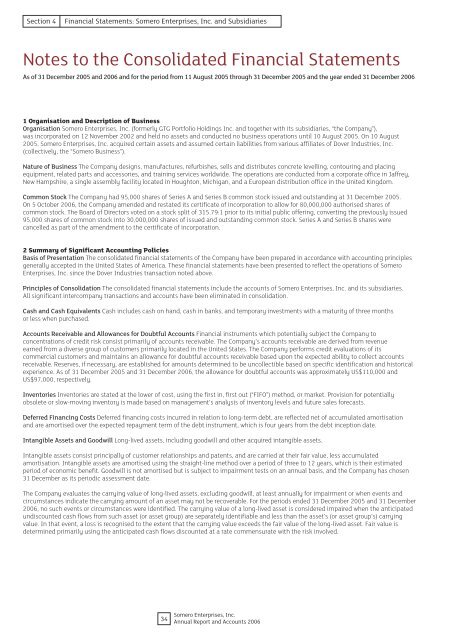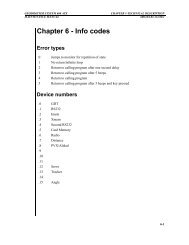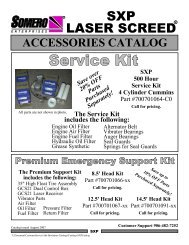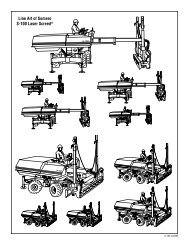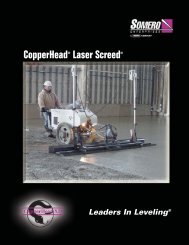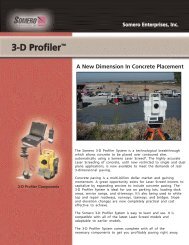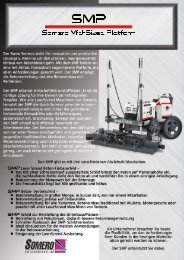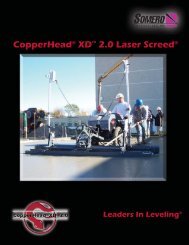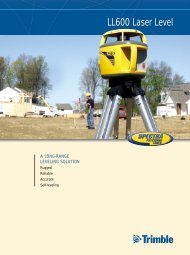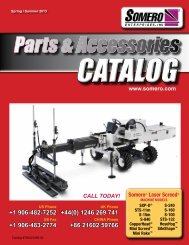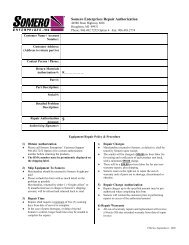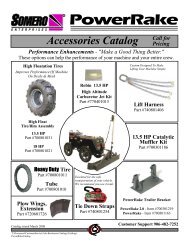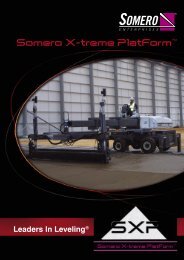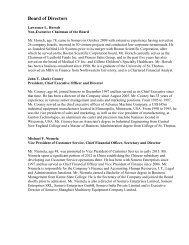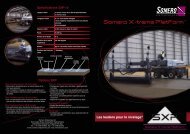PDF - Somero Enterprises
PDF - Somero Enterprises
PDF - Somero Enterprises
- No tags were found...
Create successful ePaper yourself
Turn your PDF publications into a flip-book with our unique Google optimized e-Paper software.
Section 4Financial Statements: <strong>Somero</strong> <strong>Enterprises</strong>, Inc. and SubsidiariesNotes to the Consolidated Financial StatementsAs of 31 December 2005 and 2006 and for the period from 11 August 2005 through 31 December 2005 and the year ended 31 December 20061 Organisation and Description of BusinessOrganisation <strong>Somero</strong> <strong>Enterprises</strong>, Inc. (formerly GTG Portfolio Holdings Inc. and together with its subsidiaries, “the Company”),was incorporated on 12 November 2002 and held no assets and conducted no business operations until 10 August 2005. On 10 August2005, <strong>Somero</strong> <strong>Enterprises</strong>, Inc. acquired certain assets and assumed certain liabilities from various affiliates of Dover Industries, Inc.(collectively, the “<strong>Somero</strong> Business”).Nature of Business The Company designs, manufactures, refurbishes, sells and distributes concrete levelling, contouring and placingequipment, related parts and accessories, and training services worldwide. The operations are conducted from a corporate office in Jaffrey,New Hampshire, a single assembly facility located in Houghton, Michigan, and a European distribution office in the United Kingdom.Common Stock The Company had 95,000 shares of Series A and Series B common stock issued and outstanding at 31 December 2005.On 5 October 2006, the Company amended and restated its certificate of incorporation to allow for 80,000,000 authorised shares ofcommon stock. The Board of Directors voted on a stock split of 315.79:1 prior to its initial public offering, converting the previously issued95,000 shares of common stock into 30,000,000 shares of issued and outstanding common stock. Series A and Series B shares werecancelled as part of the amendment to the certificate of incorporation.2 Summary of Significant Accounting PoliciesBasis of Presentation The consolidated financial statements of the Company have been prepared in accordance with accounting principlesgenerally accepted in the United States of America. These financial statements have been presented to reflect the operations of <strong>Somero</strong><strong>Enterprises</strong>, Inc. since the Dover Industries transaction noted above.Principles of Consolidation The consolidated financial statements include the accounts of <strong>Somero</strong> <strong>Enterprises</strong>, Inc. and its subsidiaries.All significant intercompany transactions and accounts have been eliminated in consolidation.Cash and Cash Equivalents Cash includes cash on hand, cash in banks, and temporary investments with a maturity of three monthsor less when purchased.Accounts Receivable and Allowances for Doubtful Accounts Financial instruments which potentially subject the Company toconcentrations of credit risk consist primarily of accounts receivable. The Company’s accounts receivable are derived from revenueearned from a diverse group of customers primarily located in the United States. The Company performs credit evaluations of itscommercial customers and maintains an allowance for doubtful accounts receivable based upon the expected ability to collect accountsreceivable. Reserves, if necessary, are established for amounts determined to be uncollectible based on specific identification and historicalexperience. As of 31 December 2005 and 31 December 2006, the allowance for doubtful accounts was approximately US$110,000 andUS$97,000, respectively.Inventories Inventories are stated at the lower of cost, using the first in, first out (“FIFO”) method, or market. Provision for potentiallyobsolete or slow-moving inventory is made based on management’s analysis of inventory levels and future sales forecasts.Deferred Financing Costs Deferred financing costs incurred in relation to long-term debt, are reflected net of accumulated amortisationand are amortised over the expected repayment term of the debt instrument, which is four years from the debt inception date.Intangible Assets and Goodwill Long-lived assets, including goodwill and other acquired intangible assets.Intangible assets consist principally of customer relationships and patents, and are carried at their fair value, less accumulatedamortisation. Intangible assets are amortised using the straight-line method over a period of three to 12 years, which is their estimatedperiod of economic benefit. Goodwill is not amortised but is subject to impairment tests on an annual basis, and the Company has chosen31 December as its periodic assessment date.The Company evaluates the carrying value of long-lived assets, excluding goodwill, at least annually for impairment or when events andcircumstances indicate the carrying amount of an asset may not be recoverable. For the periods ended 31 December 2005 and 31 December2006, no such events or circumstances were identified. The carrying value of a long-lived asset is considered impaired when the anticipatedundiscounted cash flows from such asset (or asset group) are separately identifiable and less than the asset’s (or asset group’s) carryingvalue. In that event, a loss is recognised to the extent that the carrying value exceeds the fair value of the long-lived asset. Fair value isdetermined primarily using the anticipated cash flows discounted at a rate commensurate with the risk involved.34<strong>Somero</strong> <strong>Enterprises</strong>, Inc.Annual Report and Accounts 2006


